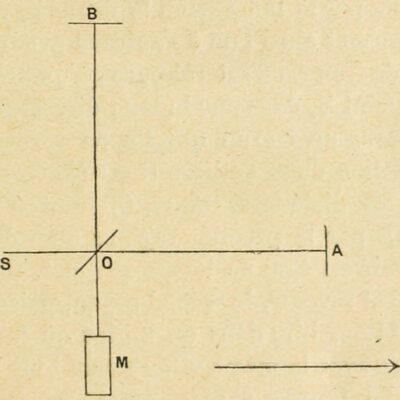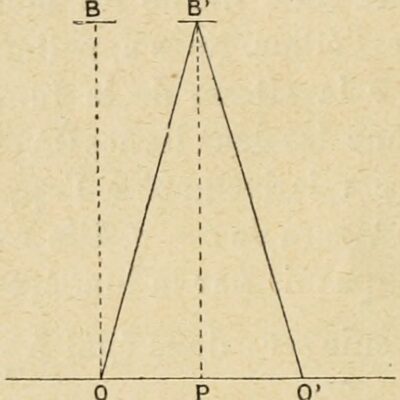The theory of relativity, even “restricted”, is not precisely based on the Michelson-Morley experiment, since it expresses, in a general way, the need to preserve the laws of electromagnetism in an invariable form when passing from one system of reference to another. But the Michelson-Morley experiment has the great advantage of posing the problem to be solved in concrete terms, and also of putting before our eyes the elements of the solution. It materializes, so to speak, the difficulty. It is from it that the philosopher must start, it is to it that he must constantly refer, if he wants to grasp the true meaning of the considerations of time in the theory of relativity. How many times has it been described and commented on! However, we must comment on it, even describe it again, because we are not going to adopt straight away, as we usually do, the interpretation given to it today by the theory of relativity. We want to manage all the transitions between the psychological point of view and the physical point of view, between the Time of common sense and that of Einstein. To do this, we must return to the state of the soul in which we could find ourselves originally, when we believed in the motionless ether, in absolute rest, and yet we had to account for the Michelson-Morley experience. We will thus obtain a certain conception of Time which is half relativistic, on one side only, which is not yet that of Einstein, but which we deem essential to know. The theory of relativity may well take no account of it in its properly scientific deductions: it nevertheless undergoes its influence, we believe, as soon as it ceases to be a physics to become a philosophy. The paradoxes that have so frightened some, so seduced others, seem to us to come from there. They hold on to an ambiguity. They arise from the fact that two representations of Relativity, one radical and conceptual, the other attenuated and colorful, accompany each other unwittingly in our minds, and from the fact that the concept undergoes the contamination of the image.
Let us therefore describe schematically the experiment instituted in 1881 by the American physicist Michelson, repeated by him and Morley in 1887, begun again with even greater care by Morley and Miller in 1905. A ray of light SO (fig. I) from the source S is divided, at point 0, by a glass plate inclined at 45° to its direction, into two rays, one of which is reflected perpendicular to SO in the direction OB while the other continues its route in the extension OA of SO. At points A and B, which we will assume equidistant from O, there are two plane mirrors perpendicular to OA and to OB. The two rays, reflected by mirrors B and A respectively, return to O: the first, crossing the glass slide, follows the line OM, an extension of BO; the second is reflected by the film along the same line OM. They are thus superimposed on each other and produce a system of interference fringes that can be observed, from point M, in a telescope directed along MO.
Suppose for a moment that the device is not in translation in the ether. It is obvious first of all that, if the distances OA and OB are equal, the time taken by the first ray to go from A to and back is equal to the time taken by the second ray to go from B to return, since the apparatus is stationary in a medium where light propagates with the same speed in all directions. The appearance of the interference fringes will therefore remain the same for any rotation of the device. It will be the same, in particular, for a rotation of 90 degrees which will cause the arms OA and OB to swap with each other.
But, in reality, the device is drawn into the movement of the Earth in its orbit (1). It is easy to see that, under these conditions, the double journey of the first ray should not have the same duration as the double journey of the second (2).
Notes
- (1) We can consider the movement of the Earth as a rectilinear and uniform translation for the duration of the experiment.
- (2) It should not be forgotten, in what follows, that the radiations emitted by the source S are immediately deposited in the immobile ether and therefore independent, as regards their propagation, of the movement of the source.
Source: Henri Bergson, Durée et simultanéité : à propos de la théorie d’Einstein, Deuxième édition, qugmentée, Paris, 1923. Translation and interpretation Nicolae Sfetcu. © 2023 MultiMedia Publishing











Gheorghe Adrian
Bergson incearca sa impace paradoxurile relativitatii cu filozofia, ca sa valideze in plus teoria. Relativitatea a fost inventata tocmai pentru a explica experimentele celebre, a lui Fizeau care verifica cu precizie formula lui Fresnel de compunere a vitezelor si a lui M-M Bergson nu cunostea faptul ca rezultatul experimentului se explica foarte simplu prin cuplajul luminii cu campul de densitate emanat in spatiu de substanta Pamantului, fara sa fie nevoie de antrenarea eterului si de metafizica relativista. Nu l-a interesat de loc faptul ca factorul relativist beta este metafizic. Fiindca nu se poate compara translatia fictiva dintre sisteme cu translatia reala a luminii. Si fiind factor metafizic, face toata relativitatea o teorie metafizica, care sustine miscarea fara suport material , intrun vid gol sec.